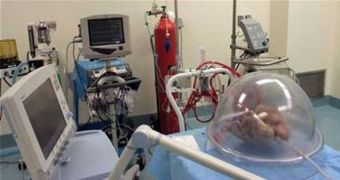Lung diseases such as cancer and edema can easily cause a person to die, if advanced enough. For these people, getting a lung transplant is oftentimes the only chance they have at life. In the United States alone, there are currently over 1,800 people waiting on transplant lists, but the thing is that insufficient organs are available for all of them, which means that some will unfortunately die. Now, scientists looking at a way of making that history announce the creation of a new gene therapy that could help boost the number of available lungs and save many lives in the process, Technology Review reports.
Canadian researchers from the McEwen Center for Regenerative Medicine, in Toronto, devised in the past a system that allowed for lungs to be kept “alive for longer.” The approach relies on using artificial nutrients, proteins, as well as a continuously pumping circulatory system, in order to make the organ “believe” it operates under physiologically normal conditions. In their innovative, new study, the scientists report the use of another molecule, the anti-inflammatory factor Il-10, to reduce the swelling that occurs in the organ after its owner dies.
Details of the procedure are published in this week's issue of the top journal Science Translational Medicine, the Canadian team reports. According to the researchers, the harvested lungs treated with the new gene therapy exhibited a better blood flow and less swelling than conventionally treated ones for more than 30 days after they were harvested. The trial study was performed on both humans and pigs. While the human test results have yet to come in, pigs that received a lung treated in this manner showed improved function in the organ, when compared to pigs that received a normally treated lung.
“They then took human lungs that were considered too damaged for transplantation and subjected them to the same procedure. The treatment significantly improved blood flow through the lungs and improved their ability to take in fresh oxygen and remove carbon dioxide. The higher levels of IL-10 persisted in the lungs for 30 days, suggesting that the procedure could also reduce rejection of the organs. The lungs were not implanted in humans,” an article in the Los Angeles Times concludes.

 14 DAY TRIAL //
14 DAY TRIAL //